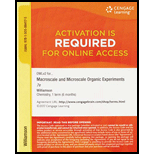
Interpretation:
Reason behind the removal of the stopper from a separatory funnel when liquid is being drained from it should be explained.
Concept introduction:
For daily laboratory liquid-liquid extraction, a separatory funnel is used. Two immiscible solvents can be readily separated by using the extraction technique.
Generally, one of the phases is organic, while the other is aqueous. The mixture of solvents that need to be extracted is poured from the top while stopcock at the bottom is still attached. Funnel is closed using a stopper,and two of the solvents are shaken together. Afterward funnel is inverted. The stopper is removed, and after the separation of layers, liquids are taken out in separate glassware.
Trending nowThis is a popular solution!

Chapter 7 Solutions
MACROSCALE+MICRO.ORG...-OWLV2 ACCESS
- Explain the importance of using a thermometer in the simple distillation setup. Enumerate the characteristics of a substance for it to be separated from the heterogeneous mixture by steam distillation. How does steam facilitate the distillation of essential oils? Discuss some applications of simple distillation and steam distillation. Explain why you can use each method for the chosen application. What is the most dominant intermolecular forces of attraction that exist between: a. water and limonene, the major monoterpene component of lemon essential oil? b. water and constituent ions of sodium chloride? 6. Based on your answers in number 5, which pair (water-limonene or water-sodium chloride) exhibits a stronger attraction between their molecules/ions? 7. Describe what happens during the salting-out process in terms of the intermolecular forces of attraction involved as mentioned in your previous answers.arrow_forwardDescribe how fractional distillation can better purify a mixture of liquids by discussing a liquid vapor phase diagram. Draw a liquid vapor phase diagram and use this in your answer.arrow_forwardWhat is meant by coagulation of a colloidal solution? Describe any three methods by which coagulation of lyophobic sols can be carried out.arrow_forward
- In Part B of this experiment you added blue food dye to a mixture of water and cyclohexane and found that the food dye dissolved exclusively in one of the two layers (the two layers were an aqueous water layer and a non-aqueous cyclohexane layer). What can you deduce from this observation about the relative strengths of the forces between the food dye and water and cyclohexane? Select one: O a. The relative strengths of the forces between the food dye and water and cyclohexane have no impact on the solubility of the food dye in either the aqueous (water) or non-aqueous (cyclohexane) layers. O b. There is not enough information available from these observations to be able to say anything about the relative strengths of the forces between the food dye and water and cyclohexane O c. The intermolecular forces between cyclohexane and the food dye are stronger than those between water and the food dye Od. The intermolecular forces between water and the food dye are stronger than those…arrow_forwardExplain why the presence of a non volatile solute in solution reduces the tendency of the solvent molecule from escaping.arrow_forwardWhen water is shaken with hexane, the two liquids separate into two phases. Which compound is present in the top phase, and which is present in the bottom phase? When water is shaken with chloroform, a similar two-phase system results. Again, which compound is present in each phase? Explain the difference between the two experiments. What do you expect to happen when water is shaken with ethanol (CH3CH2OH)?arrow_forward
- What gas law is applicable to the fractional distillation of ethanol-water mixture?arrow_forwardWrite the ions present in solution of Sn(NO2)4.Express your answers as chemical formulas separated by a comma (NO spaces!).Identify all of the phases in your answer (e.g. NO3-(aq),Cu2+(aq) ) ---------- Write the ions present in solution of NaHCO3.Express your answers as chemical formulas separated by a comma (NO spaces!).Identify all of the phases in your answer (e.g. NO3-(aq),Cu2+(aq) ) ---------- Even salts that are classified as "insoluble" according to the solubility rules will dissolve a small amount in water. Write the ions present in solution of CaSO4.Express your answers as chemical formulas separated by a comma (NO spaces!).Identify all of the phases in your answer (e.g. NO3-(aq),Cu2+(aq) )arrow_forwarddefine osmolarity and tonicity and explain theirimportancearrow_forward
- escriptionSolubility (soluble, insoluble, miscible & immiscible)25 mL of water and 1 g of salt—the resulting mixture is clear and colorless 25 mL of water and 1 g of solid silver chloride—the resulting mixture is cloudy and solid settles out. 25 mL of water and 5 mL of mineral oil—the resulting mixture is cloudy and gradually separates into two layers.arrow_forward302 301 300 299 298 297 (K) 296 295 294 293 292 0.2 0.4 0.6 0.8 XA According to the phase diagram shown for mixtures of A and B shown above, if xA 0.2, solid A (enter A or B) will start to precipitate from a homogeneous solution when the temperature reaches A K (enter the temperature to zero decimal places).arrow_forwardWhy is fractional distillation more efficient than simple distillation when purifying liquid mixtures?arrow_forward
 Chemistry: The Molecular ScienceChemistryISBN:9781285199047Author:John W. Moore, Conrad L. StanitskiPublisher:Cengage Learning
Chemistry: The Molecular ScienceChemistryISBN:9781285199047Author:John W. Moore, Conrad L. StanitskiPublisher:Cengage Learning Principles of Modern ChemistryChemistryISBN:9781305079113Author:David W. Oxtoby, H. Pat Gillis, Laurie J. ButlerPublisher:Cengage Learning
Principles of Modern ChemistryChemistryISBN:9781305079113Author:David W. Oxtoby, H. Pat Gillis, Laurie J. ButlerPublisher:Cengage Learning General, Organic, and Biological ChemistryChemistryISBN:9781285853918Author:H. Stephen StokerPublisher:Cengage Learning
General, Organic, and Biological ChemistryChemistryISBN:9781285853918Author:H. Stephen StokerPublisher:Cengage Learning- Chemistry: Matter and ChangeChemistryISBN:9780078746376Author:Dinah Zike, Laurel Dingrando, Nicholas Hainen, Cheryl WistromPublisher:Glencoe/McGraw-Hill School Pub Co
 Chemistry & Chemical ReactivityChemistryISBN:9781337399074Author:John C. Kotz, Paul M. Treichel, John Townsend, David TreichelPublisher:Cengage Learning
Chemistry & Chemical ReactivityChemistryISBN:9781337399074Author:John C. Kotz, Paul M. Treichel, John Townsend, David TreichelPublisher:Cengage Learning




